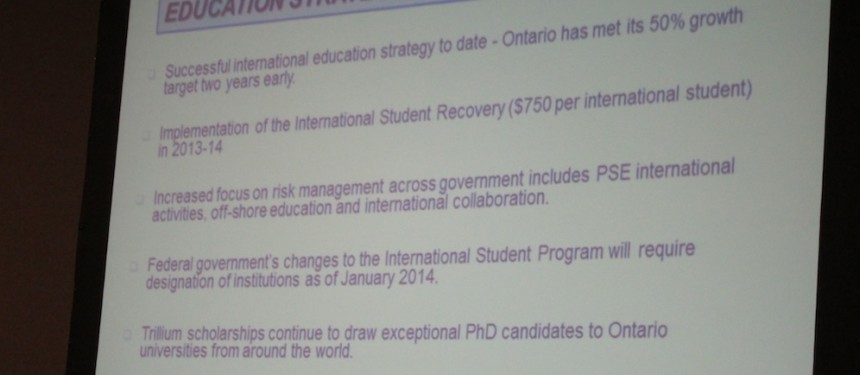The government of Ontario in Canada is working to establish a new target of international students in light of the fact that the populous province has reached the objective set by the federal government to attract 57,000 international students by 2015 two years early. Its new target will be set against a backdrop of a new “head tax” on international students that has been charged since April this year.
News and business analysis for Professionals in International Education
Have some pie!
Ontario meets 57k target two years early
 An extract from a presentation made at NAFSA indicating Ontario's successful international education strategy
An extract from a presentation made at NAFSA indicating Ontario's successful international education strategy A spokesman at the Ministry of Training, Colleges and Universities (MTCU) confirmed that “Ontario is working to determine a new target” which could be influenced by last year’s recommendations by a federal advisory panel that the government double the number of foreign students from 239,131 in 2011 to more than 450,000 by 2022.
However, educators in the province are seeking to build enrolments while now negotiating the International Student Recovery (ISR) scheme, which essentially saw university funding reduced by CAN$750 per head for its international student population as the province tries to deal with its own fiscal challenges.
Some institutions have passed the funding loss on to students resulting in it being referred to as a “head tax” and raising concerns that enrolments could be affected.
He observed that Canada continued to present a competitive offer to international students
Speaking with The PIE News, Vice-Provost at The University of Windsor, Clayton Smith said: “What is odd here is the message. On the one front the Ontario government has endorsed increasing international student enrolments by 50% and then reduces our institutional base grant equal to $750 for each international student enrolled.”
Smith said that in his case, the university did not pass on the cuts to students but is holding out for improved government support. “Our hope is that it is a temporary move and the government will soon redouble its efforts to support international students on our campuses.”
Speaking at the NAFSA Conference this year in the USA, Senior Policy Advisor at Ontario’s Ministry for Training, Colleges and Universities, John Shalagan, said that it was too early to tell if there had been any impact of the new $750 fee requirements, which are being rolled out in stages.
However, he observed that Canada continued to present a competitive offer to international students – particularly in light of its generous post-study work arrangements.
Indeed, in a recent BoCom Sea Turtle Index of cities offering best return on investment based on five factors (educational returns, work experience, social experience, financial returns and real estate-related returns), Toronto appears in fourth position in this index aimed at Chinese consumers.
Announced last year, the ISR will be phased in over four years starting with first year international students in 2013-2014 and extending to second year students in 2014, third years in 2015 and eventually all enrolled international students in all years and levels of programmes, with the exception of PhD students, by 2016. It will not apply to ESL students.
The government will maintain funding for PhD students to boost research capacity and global competitiveness of the province’s universities, confirmed the MTCU. “International PhD students are a vital resource for Ontario’s prosperity. A third of our PhD students in the fields of Science, Technology, Engineering and Math are international students.”
The ISR scheme will not apply to ESL students
Last year educators said they were taken by surprise by the funding cuts leaving them little choice but to increase fees and narrowing the background of international students who could afford to attend universities in Ontario.
The sector was also concerned that Ontario would lose ground to other provinces not increasing fees. Ontario currently has the highest average level tuition fees and second highest average university undergraduate tuition for foreign students.
However, during the NAFSA session, Shalagan observed that the province – which has to deal with difficult budgetary issues – is also home to half of the 20 highest-ranked institutions in the country.
His position was supported by some of the delegates in the session, one of whom observed that foreign-born students should not be expected to benefit from provincial funding raised from domestically-raised taxes.
Still looking? Find by category:


